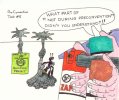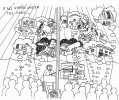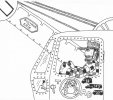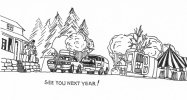Stellafane Art by Russ Chmela
All artwork on this page is copyrighted © 1999 by Russ Chmela.
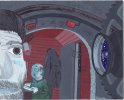
Click to view:
Medium Size (42k File)
Large Size (162k File)
Observing with the Porter Turret Telescope
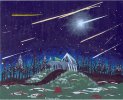
Click to view:
Medium Size (62k File)
Large Size (252k File)
"Leonid Storm!!" Will the Lion Roar this year? Many will be watching. Perhaps Schupmann Hill will be the eye of the storm.
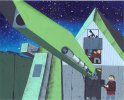
Click to view:
Medium Size (47k File)
Large Size (189k File)
"Porter Would Approve" Completed in the mid 1990's, the McGregor Observatory and it's Schupmann Telescope is shown ready and observing into the next century and millennium. Named for a departed member of the Springfield Telescope Makers, this observatory houses the largest Schupmann telescope in use today in the world. Innovative in many ways, from a new style of roll-off-roof building, which makes useful space under the roof when open, to the computer driven alt-azimuth as equatorial mount, this observatory will be unique for many years to come. Not unique is the fact that this entire complex was designed, funded and build entirely by amateur telescope makers and a volunteer spirit typical to the hobby.
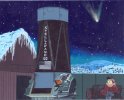
Click to view:
Medium Size (51k File)
Large Size (220k File)
"A Future Idea?" Many possibilities exist for future Stellafane projects. Although I no longer live in New England, I do occasionally think up a "Dream Telescope" for myself and sometimes for the Springfield Telescope Makers. Consider the concept of a large aperture telescope for either visual or image use. A 60" telescope on an alt-azimuth mount driven as equatorial. The tube assembly to use a light-weight upper end and a truss framing and a Naysmith focus to allow a seated observer at floor level. The observatory building, designed for simplicity and cost effectiveness, to be located on the newest Stellafane land added recently. The need for such a new telescope will be gauged from the scheduling, or more precisely, the over scheduling, of the McGregor Telescope. A new direction in observing technology, it may require a simpler-is-better shift in ideas to become practical.
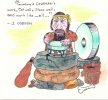
Click to view:
Medium Size (39k File)
Large Size (455k File)
"Grinding is caveman's work: Eat well, sleep well and work like hell". -- John Dobson
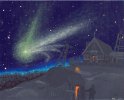
Click to view:
Medium Size (42k File)
Large Size (203k File)
"Send Us More Comets!!" After Hyakutake and Hale-Bopp it is found that years with big bright comets are more fun than years without them.
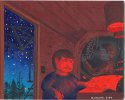
Click to view:
Medium Size (46k File)
Large Size (193k File)
This scene depicts a late summer night in 1993 and a many-hour observing session. The Porter Turret Telescope had recently been remodeled including map and floor lighting and interior paneling as well as a computer. Beginning with some seven Club members, the later hours saw only Brad Vietje and Russ Chmela at the focuser. The positions of the two observers show a very good approach to the problem of finding objects with a telescope that does not have a finder telescope or any outside view of the sky. With one observer at the focus, operating the controls, drive and setting circles, and the other observer selecting objects from the atlas and reading the coordinates to the operator. From time to time, both will swap tasks and, for most objects, both take their turn at the eyepiece. Using this technique, objects can be found almost as fast as a conventional telescope. The views with this instrument are exceptional and have proven to be exceptional on many deep-sky objects. Making a long and scenic observing run on a historic and unique instrument is a memorable entry in any observing log book.
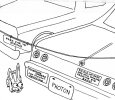
Click to view:
Medium Size (38k File)
Large Size (91k File)

Click to view:
Medium Size (24k File)
Large Size (69k File)
"Grinding and Testing Telescope Mirrors"


